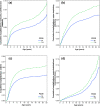Pregnancy-related outcomes for women with polycystic ovary syndrome
- PMID: 28934902
- PMCID: PMC7789031
- DOI: 10.1177/1745505717731971
Pregnancy-related outcomes for women with polycystic ovary syndrome
Abstract
The polycystic ovary syndrome is a common endocrine disorder that has profound implications for women throughout their reproductive years. A diagnosis of polycystic ovary syndrome is associated with reproductive challenges including a difficulty in conceiving as well as the pregnancy-related complications of miscarriage, hypertensive disorders, gestational diabetes and prematurity. Consequently, polycystic ovary syndrome has profound implications for women and their offspring with regard to reproductive function in the short term and in the longer term the risk of chronic illness and congenital anomalies, and health care resources should be directed accordingly to mitigate against these risks.
Keywords: complications; polycystic ovary syndrome; pregnancy; reproduction.
Conflict of interest statement
Figures


Similar articles
-
Pregnancy complications in women with polycystic ovary syndrome.Hum Reprod Update. 2015 Sep-Oct;21(5):575-92. doi: 10.1093/humupd/dmv029. Epub 2015 Jun 27. Hum Reprod Update. 2015. PMID: 26117684 Review.
-
A meta-analysis of pregnancy outcomes in women with polycystic ovary syndrome.Hum Reprod Update. 2006 Nov-Dec;12(6):673-83. doi: 10.1093/humupd/dml036. Epub 2006 Aug 4. Hum Reprod Update. 2006. PMID: 16891296 Review.
-
[Polycystic ovary syndrome: what are the obstetrical risks?].Gynecol Obstet Fertil. 2014 Feb;42(2):104-111. doi: 10.1016/j.gyobfe.2014.01.001. Epub 2014 Jan 28. Gynecol Obstet Fertil. 2014. PMID: 24485279 Review. French.
-
Obstetric complications after frozen versus fresh embryo transfer in women with polycystic ovary syndrome: results from a randomized trial.Fertil Steril. 2018 Feb;109(2):324-329. doi: 10.1016/j.fertnstert.2017.10.020. Epub 2018 Jan 17. Fertil Steril. 2018. PMID: 29338857 Clinical Trial.
-
Lifestyle and pregnancy complications in polycystic ovary syndrome: The SCOPE cohort study.Clin Endocrinol (Oxf). 2019 Jun;90(6):814-821. doi: 10.1111/cen.13954. Epub 2019 Apr 1. Clin Endocrinol (Oxf). 2019. PMID: 30801750
Cited by
-
Utero-placental (vascular) development throughout pregnancy in women with polycystic ovary syndrome: the Rotterdam Periconceptional Cohort.F S Rep. 2024 Dec 19;6(1):79-89. doi: 10.1016/j.xfre.2024.12.002. eCollection 2025 Mar. F S Rep. 2024. PMID: 40201084 Free PMC article.
-
Women with polycystic ovary syndrome present with altered endometrial expression of stanniocalcin-1†.Biol Reprod. 2020 Feb 14;102(2):306-315. doi: 10.1093/biolre/ioz180. Biol Reprod. 2020. PMID: 31494675 Free PMC article.
-
Association between preconception anti-androgen therapy and pregnancy outcomes of patients with PCOS: A prospective cohort study.Front Endocrinol (Lausanne). 2023 Jan 30;14:1109861. doi: 10.3389/fendo.2023.1109861. eCollection 2023. Front Endocrinol (Lausanne). 2023. PMID: 36793270 Free PMC article.
-
Polycystic Ovary Syndrome and Irritable Bowel Syndrome: Is There a Common Pathway?Endocrinol Diabetes Metab. 2024 Mar;7(2):e00477. doi: 10.1002/edm2.477. Endocrinol Diabetes Metab. 2024. PMID: 38494583 Free PMC article. Review.
-
Polycystic ovary syndrome and chronic pain among females and individuals of childbearing age: A scoping review.SAGE Open Med. 2024 Jun 19;12:20503121241262158. doi: 10.1177/20503121241262158. eCollection 2024. SAGE Open Med. 2024. PMID: 38903491 Free PMC article.
References
-
- Azziz R, Carmina E, Chen Z, et al. Polycystic ovary syndrome. Nat Rev Dis Primers 2016; 2: 16057. - PubMed
-
- Rotterdam ESHRE/ASRM-Sponsored PCOS consensus workshop group. Revised 2003 consensus on diagnostic criteria and long-term health risks related to polycystic ovary syndrome (PCOS). Hum Reprod 2004; 19(1): 41–47. - PubMed
-
- Goodman NF, Cobin RH, Futterweit W, et al. American association of clinical endocrinologists, American college of endocrinology, and androgen excess and PCOS society disease state clinical review: guide to the best practices in the evaluation and treatment of polycystic ovary syndrome—part 2. Endocr Pract 2015; 21(12): 1415–1426. - PubMed
-
- Homburg R. Polycystic ovary syndrome. Best Pract Res Clin Obstet Gynaecol 2008; 22(2): 261–274. - PubMed
-
- Nelson VL, Qin KN, Rosenfield RL, et al. The biochemical basis for increased testosterone production in theca cells propagated from patients with polycystic ovary syndrome. J Clin Endocrinol Metab 2001; 86(12): 5925–5933. - PubMed
MeSH terms
LinkOut - more resources
Full Text Sources
Other Literature Sources
Medical

